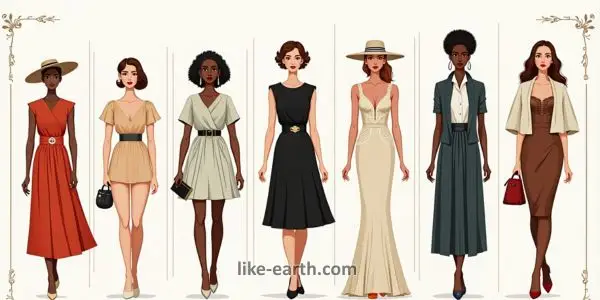Fashion Evolution: Year-by-Year Style Comparison

Introduction: Year-by-Year Style Comparison Fashion
Fashion Evolution is a reflection of its era, and a year-by-year style comparison fashion guide can reveal the transformation of cultural identity, technology, and societal values through clothes. As we walk through decades of changing wardrobes, it’s clear that style is more than aesthetics—it’s expression, rebellion, and storytelling.
The 1920s: The Age of Liberation
The 1920s marked a revolution in fashion. Women embraced shorter hemlines and bobbed hair. Flapper dresses with fringe and sequins dominated evening wear. Men shifted toward more relaxed suits, leaving behind the restrictive Victorian silhouette. Jazz culture and the roaring economy drove this expressive wave.
The 1930s: Elegance Amidst Hardship
As the Great Depression hit, fashion turned more conservative. Long flowing gowns replaced flapper styles. Fabrics became more affordable. Bias cuts and softer shapes defined women’s clothing. Men’s suits adopted sharper tailoring, often with padded shoulders to reflect resilience.
The 1940s: Utility Meets Style
War-time rationing led to utility fashion. Women wore pants for factory work. The iconic “Rosie the Riveter” look became a symbol. Clothing was practical, using limited fabric. Yet, post-war fashion reintroduced femininity. The decade ended with Dior’s “New Look,” emphasizing full skirts and cinched waists.
The 1950s: The Golden Age of Glamour
Hollywood heavily influenced fashion. Grace Kelly and Audrey Hepburn set the tone. Hourglass figures were in vogue. Poodle skirts, twin sets, and tailored dresses filled closets. Men sported classic suits or leather jackets, à la James Dean. Suburban prosperity allowed wider fashion access.
The 1960s: Revolution and Youth Culture
The sixties brought bold experimentation. Miniskirts, go-go boots, and psychedelic prints captured youth rebellion. London’s “Mod” style, led by Twiggy and The Beatles, shook global fashion. Men’s wear also changed, with colorful shirts and slim-cut suits becoming trendy.
The 1970s: Boho Meets Disco
This era blended hippie aesthetics with flashy disco looks. Bell-bottoms, fringe, suede, and peasant blouses were everywhere. Meanwhile, disco nights saw sequins, jumpsuits, and platform shoes take over dance floors.
The 1980s: Power Dressing and Neon
The ‘80s celebrated boldness. Shoulder pads, neon colors, and oversized accessories dominated. Women’s suits took on aggressive cuts to fit into male-dominated corporate culture. Streetwear emerged through hip-hop and punk scenes. Think Madonna, Michael Jackson, and MTV influence.
The 1990s: Grunge to Minimalism
The fashion of the ‘90s started with rebellion. Flannel shirts, ripped jeans, and Doc Martens defined the grunge look. Later years moved toward minimalism. Slip dresses, denim-on-denim, and black turtlenecks reflected a more subdued tone. Designers like Calvin Klein rose to prominence.
The 2000s: Eclectic and Experimental
The new millennium saw fashion become a global mashup. Low-rise jeans, cargo pants, and halter tops were trends. Logos became central, and fast fashion took hold. Tech accessories like bedazzled phones even became style statements. The red carpet embraced both extremes and experimentation.
The 2010s: Social Media and Revival
Instagram changed how people dressed. Influencers set trends faster than magazines. The decade revived multiple past styles—high-waisted jeans from the ’90s, crop tops from the ’80s. Sustainable fashion movements began to rise, and “normcore” simplified looks into basics.
The 2020s: Digital Meets Sustainable
With the rise of TikTok and global crises like COVID-19, comfort and sustainability define this decade. Loungewear became mainstream. People mix vintage with modern pieces. Digital fashion and virtual clothing entered the scene. Ethical sourcing and transparency are now fashion priorities.
What Year-by-Year Style Reveals About Us
A year-by-year style comparison fashion chart not only shows evolving tastes but also reflects cultural shifts. Each trend tells a story. Whether it’s the rebellion of the ’60s or the cozy minimalism of the 2020s, fashion always echoes our fears, freedoms, and futures.
Understanding these changes helps us see how values evolve, how industries adapt, and how identity forms across generations.
Modern Fashion: A Blend of All Eras
Today, fashion is not confined to one trend. People pull inspiration from every decade. You might see a 1970s blouse with 2000s jeans and 2020s sneakers. This era is about self-expression and versatility. It’s never been easier—or more accepted—to mix styles.
Looking Forward: The Future of Style
AI-generated fashion, virtual wardrobes, and climate-conscious clothing will define the next chapters. As trends become more data-driven, individuality remains vital. People want fashion that fits both their identity and their values.
Conclusion: Wearing Our History
From flappers to influencers, style reflects history. By examining a year-by-year style comparison fashion evolution, we understand more than outfits—we see culture unfold. Keep up with the trends and deeper meanings by exploring our main site at Like Earth.
For instant updates and engaging polls, join our WhatsApp Channel where fashion and culture collide daily. Fashion Evolution



